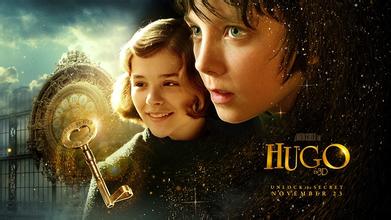(单词翻译:单击)

【电影简介】
电影讲述了在20世纪30年代的巴黎,在父亲死后,12岁的孤儿雨果被交给他的叔叔照顾,他的工作是维护火车站的27座时钟工作正常。雨果住在火车站的高墙内,在熙攘的人群中穿梭,藏身于大钟后方,冷眼观察来往过客,藏着满脑子秘密。他那死去的父亲给他留下的唯一遗产,就是一个坏掉的机器人,要修好它,雨果必须找到一把心形的钥匙,他相信这是父亲给他留下的信息。
雨果在火车站里偷取零件时,被火车站的玩具店老板乔治抓了个正着,因此结识了乔治的教女伊莎贝拉。出人意料的是,伊莎贝拉刚好有一把心形钥匙,靠着这把钥匙,雨果发现了机器人中藏着的秘密,更让他惊讶的是,原来玩具店老板就是当时已被人遗忘的电影先驱乔治·梅里埃,他的电影曾让雨果和他的父亲深深痴迷。
【音频文本】
When the 69 year old film director Martin Scorsese decided that he needed a break from violence and pain, the world took note. His 2011 family film 'Hugo' sent many critics head over heels as they cheered its technical triumph. However, as we'll see, not everyone was intoxicated by the stunning visual display.
Firstly, let's unveil the mysterious glamour that charmed the critics and the Academy. Scorsese was inspired by his 12 year old daughter who presented him with a copy of Brian Selnick's novel 'The Invention of Hugo Cabret' and suggested that he make it into a 3D movie. This is the back story to Scorsese's first PG rated film in 18 years. Regardless of whether he was trying to please his daughter or not, Martin is pretty serious about the use of 3D visual effects, and his exercise using the Fusion Camera technique drew the admiration of James Cameron, who referred to it as a "masterpiece."
But his emphasis on visual effects did not stop with the 3D aspect of the film; he also utilized the best Arri Alexa camera, which, combined with the ingenuity of Robert Richardson and intense editing, created the most spectacular visuals that eventually secured the Award for Best Visual Effects at the 84th Academy Awards. The digitally enhanced recreation of Gare Montparnasse and the occasional rooftop overviews of Paris' streets, all of which dated back to the 1930s, provided more than enough for the eyes to explore, and instantly took audiences back to Charles Dickens' London of hungry orphans, runaway wives and courtly dialogue with big words.
However, the story is problematic, especially when you care to look closely. I believe the majority of Martin Scorsese's focus was placed on producing this mysterious ambience of a children's story, and in doing so he neglected logic. At the beginning of this piece, when the automaton appeared, I expected a steampunkscience fiction presentation; similar to that of Bicentennial Man by Chris Columbus. But halfway into the film, the idea of cinema and adventure took charge, and it was only after the last voiceover that I realized Hugo was actually a family film. I'm not blaming Scorsese for causing me to fail my favorite guessing game, but YES, look how confused I was.
The story is confusing because Scorsese tries to achieve too much within 126 minutes. Aside from telling achildren's story, he has also tried to pay tribute to movie pioneer George Melies. Other insignificant additions, such as bemoaning the loss of the war and recreating a train derailment, contributed nothing to the main theme of family.
So, as you see, Martin Scorsese's success with visual effects was remarkable, but the unattended storylinecould bore even the least critical of children. Ultimately, Hugo could give you the perfect night with your kids: you take them to the cinema; you observe the excitement in their eyes when the story begins; and when they are sound asleep, you take them home straight to the bed.
On my scale from one to ten, Hugo gets a six, including bonus points due to the visuals.
轻松调频EZFM 微信mrweekly


